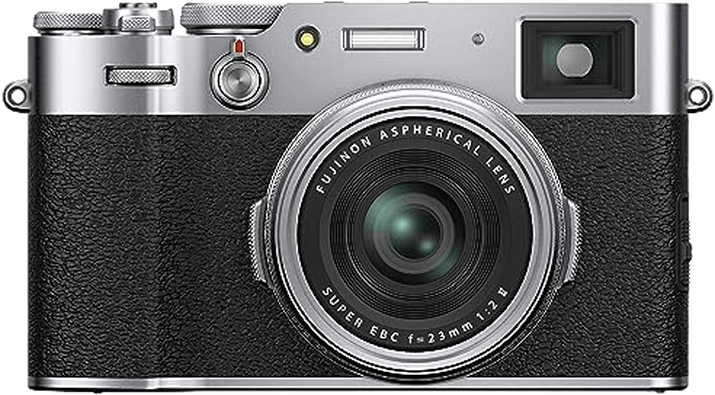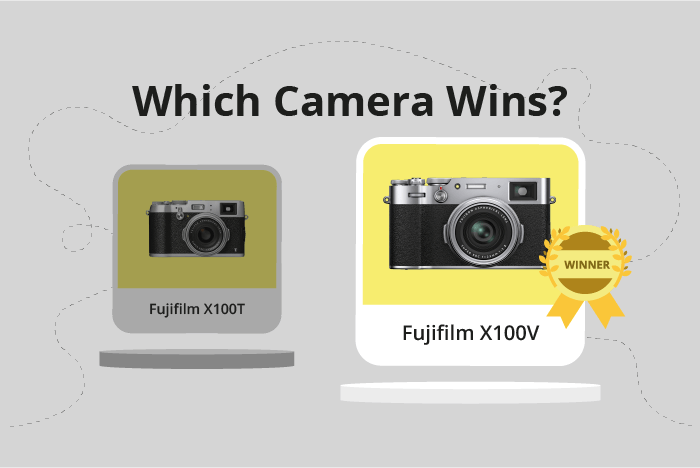Fujifilm X100T vs X100V Comparison
Fujifilm X100T

Fujifilm X100V

The Fujifilm X100V emerges as the winner with a score of 69/100, while the Fujifilm X100T trails behind at 53/100. Both cameras are mirrorless and share similar dimensions, with the X100V slightly larger and heavier. The X100V was released in 2020 at a launch price of $1399, whereas the X100T was introduced in 2015 for $1300.
The X100V’s higher score indicates that it has superior features and performance compared to the X100T. However, the X100T still has its merits, especially considering its lower launch price. Although it is an older model, it is a lighter option for those who prioritize portability.
Ultimately, the Fujifilm X100V offers better value for the higher price, while the X100T might be suitable for budget-conscious photographers who prefer a lighter camera.
Fujifilm X100T vs X100V Overview and Optics
The Fujifilm X100V is the winner in the optics comparison, scoring 66/100, while the Fujifilm X100T scores 54/100. Both cameras share some common features, such as a CMOS sensor, APS-C sensor size, and a fixed lens mount that prevents lens changes. Additionally, neither camera has image stabilization.
The X100V outperforms the X100T in several aspects. It has a higher megapixel count of 26, compared to the X100T’s 16 megapixels, providing better image resolution and detail. The X100V also offers a faster shooting speed of 11 frames per second, compared to the X100T’s 6 frames per second. This allows for capturing fast-moving subjects more effectively. Furthermore, the X100V has an upgraded processor, the X-Processor 4, which contributes to improved image processing and overall performance.
On the other hand, the X100T still has some advantages despite its lower score. Its lower megapixel count may benefit photographers who require less storage space or faster file transfer times. Additionally, the X100T’s slower shooting speed may be sufficient for photographers who do not need to capture fast action.
In comparing the optics of the Fujifilm X100T and X100V, the X100V is the better camera due to its higher resolution, faster shooting speed, and improved processor. However, photographers who prioritize smaller file sizes or do not require rapid shooting speeds may still find value in the X100T. Ultimately, the choice between these two cameras will depend on individual needs and preferences.
Fujifilm X100T vs X100V Video Performance
The Fujifilm X100V outperforms the Fujifilm X100T in video capabilities with a significant difference of 21 points in their video scores, 91/100 for the X100V and 70/100 for the X100T. Both cameras share some common specifications, such as having built-in time-lapse functionality, which is a useful feature for capturing dynamic scenes over time.
The winning camera, the Fujifilm X100V, has superior video quality due to its 4K max video resolution and larger video dimensions of 4096 x 2160. This results in sharper and more detailed footage compared to the X100T’s Full HD max video resolution and dimensions of 1920 x 1080. Additionally, the X100V boasts a higher max video frame rate of 120fps, enabling smoother slow-motion videos and greater creative flexibility in post-production.
On the other hand, the Fujifilm X100T has a lower max video frame rate of 60fps, which still allows for basic slow-motion video capture but is not as versatile as the X100V’s 120fps. The X100T’s Full HD video resolution, while not as impressive as the X100V’s 4K, remains a standard quality for many video applications and is sufficient for casual users or those not requiring the highest level of detail.
Taking these factors into account, the Fujifilm X100V clearly surpasses the X100T in terms of video capabilities due to its higher video score, 4K resolution, and 120fps frame rate. The X100T, while not as advanced, still offers acceptable video quality for less demanding users with its Full HD resolution and 60fps frame rate. Ultimately, the choice between these cameras for video purposes depends on the user’s needs and desired level of video quality.
Fujifilm X100T vs X100V Features and Benefits
The Fujifilm X100V emerges as the winner with a feature score of 85/100, compared to the X100T’s score of 58/100. Both cameras share several specifications, such as a 3-inch screen size, flip screen, absence of GPS, and the presence of WIFI and Bluetooth connectivity.
The X100V outshines the X100T in its touchscreen capability, which the X100T lacks. This feature allows users to interact with the camera more intuitively and efficiently. Additionally, the X100V’s screen resolution is lower at 1,620,000 dots compared to the X100T’s 2,360,000 dots. This difference in resolution does not hinder the X100V’s performance; instead, it demonstrates that the camera focuses on essential features, like the touchscreen, to improve user experience.
On the other hand, the X100T has a higher screen resolution, which may provide a slightly better image preview. However, this advantage does not outweigh the benefits of the X100V’s touchscreen capability.
In comparing the features of the Fujifilm X100T and X100V, it is evident that the X100V is superior due to its touchscreen functionality. This feature enhances the user experience and makes the camera more efficient to operate. While the X100T has a higher screen resolution, it does not provide enough advantage to surpass the X100V’s overall performance and feature set.
Fujifilm X100T vs X100V Storage and Battery
The Fujifilm X100V outperforms the X100T in storage and battery with a score of 37/100 compared to the X100T’s 21/100. Both cameras share common specifications, such as having a single memory card slot and accepting SD, SDHC, and SDXC (UHS-I compatible) cards.
The X100V’s superior performance is due to its longer battery life and USB charging capabilities. It offers 420 shots per charge, while the X100T only provides 330 shots. Additionally, the X100V uses the NP-W126S battery type and supports USB charging, making it more convenient for on-the-go users.
The X100T does not surpass the X100V in any aspect of storage and battery. Its Lithium-Ion NP-95 battery lacks USB charging, and its battery life is shorter compared to the X100V.
Considering these factors, the Fujifilm X100V is the clear winner in storage and battery performance. Users will benefit from longer shooting sessions and the added convenience of USB charging. The Fujifilm X100T falls short in this category, making the X100V a more suitable choice for those prioritizing battery life and charging options.
Fujifilm X100T vs X100V – Our Verdict
Are you still undecided about which camera is right for you? Have a look at these popular comparisons that feature the Fujifilm X100T or the Fujifilm X100V:

